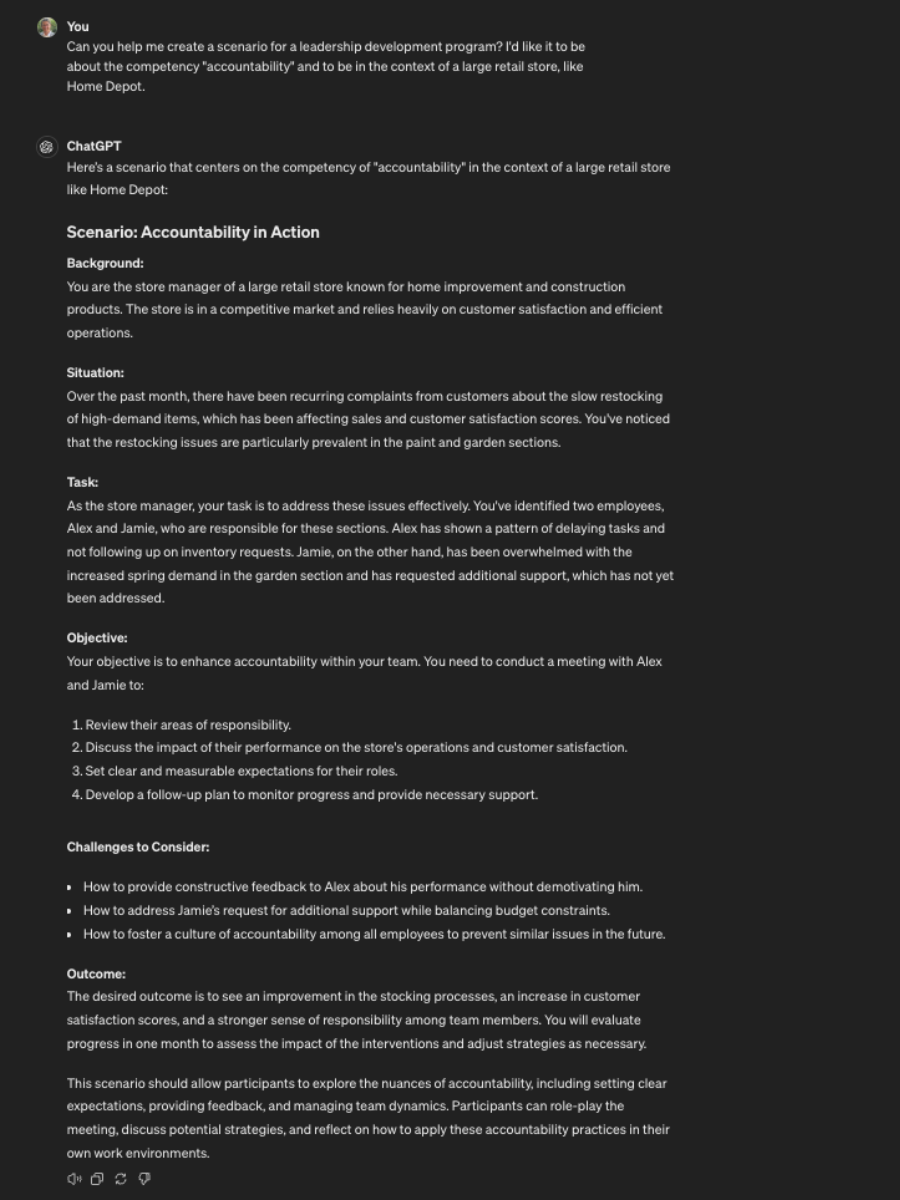
“The best time to plant a tree was twenty years ago. The second best time is right now.” —Chinese Proverb
Since Chat GPT burst onto the scene in late 2022, leadership development has seen an explosion of new technology. That said, most leadership development professionals still aren’t adopting it. In the 2024 LEADx Leadership Development Benchmark Report, we found that just 24% of leadership development professionals currently use AI in their work.
 What does that mean for you? It means that if you can keep up with the changing landscape and find a useful way to adopt new technology, you'll be an early adopter with a competitive advantage.
What does that mean for you? It means that if you can keep up with the changing landscape and find a useful way to adopt new technology, you'll be an early adopter with a competitive advantage.
What follows are five proven technologies you can adopt right now. To ground the conversation in practicality, this article draws on the experiences of GE Healthcare’s Head of L&D, Kristy Callahan, and Home Depot’s Sr. Manager of Learning Strategy, Michael Cabe. Each technology mentioned here has been used by at least one of them.
 1. Create “Digital Twins” of Your Participants to Personalize Learning
1. Create “Digital Twins” of Your Participants to Personalize Learning
LinkedIn Learning may have democratized access to learning, but digital twins are democratizing access to personalized learning. Here’s a 3-step process of what this looks like.
Step 1: You create a “digital twin” of each of your leaders. My favorite example of how a digital twin works is at wind energy farms. Wind energy farms need to keep track of how each of their 100+ windmills are holding up. So, using AI-powered software, they create a digital twin of each windmill. The digital twin accounts for things like:
- the age of the windmill and each of its parts
- the location of the windmill and how that affects each part
- the activity level of the windmill and how that affects each part
Based on this information (and much more), the software can simulate the wear and tear of each windmill. This makes it easy to forecast the need for new parts, the timing of upkeep, and the eventual need for replacement.
Now, imagine this same concept applied to your leaders. You get a digital twin that accounts for things like:
- their assessment scores (i.e., team engagement or an LCP 360)
- the personality types of their direct reports (i.e., DISC or Strengths)
- their name, time zone, and work platform (i.e., Slack, Teams, or Gmail)
It’s essentially a “twin” profile of your leader that you can use to deliver just the right content.
Step 2: Use your digital twin’s profile to send personalized behavioral nudges.
A personalized behavioral nudge is a concise prompt for action. By pulling the information from your leader’s digital twin, you can send highly relevant, specific, and timely messages.
For example, here’s a nudge giving “Jenny” a specific tip about how to best interact with her direct report, Safiya, based on Safiya’s personality:
—> Jenny, Safiya on your team has the “S” DISC style. Spend time building rapport. Ask her about her family, friends, or interests.
In just one sentence, the nudge took into account:
- her direct report’s personality and name
- her goal of engaging her team
- the fact that she works on Slack on PST (the nudge gets delivered on Slack during an hour when Jenny is likely to be online but not overwhelmed by messages)
As an added bonus, the nudges can link to deeper-dive content: Job aids, microlearning videos, podcasts, and book summaries.
Step 3️: An expert psychologist adds a human loop.
Before adding any of these nudges to our platform, a psychologist reviews EVERY single one.
This psychologist:
- flags anything that feels robotic in tone.
- identifies and eliminates any AI “hallucinations.”
- tweaks bizarre sentences to make them sound more natural.
This makes each nudge AI-generated and expert-approved.
2. Instantly Translate Learning Videos with 99% Accuracy
At Home Depot, Cabe is always looking for ways to save budget. “We all know that a big expense is translation and layering on multiple variations. It's not just ‘Spanish.’ We're in Mexico and Puerto Rico,” Cabe explained. Using a video animation tool called Vyond, Cabe is able to generate animated learning videos and then translate them across languages and locations with 99% accuracy. To make up for any glitches or oversights, he asks a partner in that country to review the translation.
In addition to paying for no translation costs, the translation is also immediate and takes just four to 10 seconds. Previously, he would wait two to three weeks per translation.
3. Use “Pooled Coaching” to Give Every Participant Access to a Coach
Pooled coaching is incredibly simple from a technology perspective. It’s message-based coaching. By using a pooled approach (picture a call center of expert coaches), you can give every leader at your company regular access to a coach for as little as $10-12/month. Of course, there are elements of coaching that get lost when using a message-based platform:
- Rapport-building: You might get a different coach tomorrow than you had today.
- Body language and tone.
But, pooled coaching isn’t designed to replace 1-on-1 executive coaching. It’s designed to give learners access to a coach who would otherwise have zero coach interaction.
While the point is not to replace executive coaching, the results are interesting. Across classic measures like “satisfaction,” “trust,” “behavior change,” “employee engagement,” and “reductions in stress,” improvements are still drastic.
4. Brainstorm, Roleplay, and Generate Specific Scenarios Using Chat GPT
Of course, using Chat GPT is the lowest-hanging fruit. For $20/month, you can immediately start using Chat GPT in your daily work. Here are three ways Cabe and Callahan use GPT in their work:
- Brainstorm: Cabe recommends using GPT to break out of your normal patterns of thinking. “I'll say, draw me up an outline on how to teach accountability for leaders. Now put this in the concepts of accountability through the lens of ‘fairness,’” Cabe said. “GPT offers me the opportunity to get unstuck and not consistently think in the same way I've always thought about these topics,” he added. Cabe recommends taking a conversational approach when using GPT. “Have an honest conversation with Chat GPT. Talk to it as if you're benchmarking and say, ‘What about doing it this way? What about putting this lens on it?’”
- Generate Scenarios: GPT also helps expedite the process from ideation to creation. “I often ask GPT to do things like ‘write a scenario in retail on how to drive accountability.’” Cabe explained. “Chat GPT will get me about 80% of the way there, then I can go in and finalize it.”
- Role Play. Callahan pointed out that many sales reps have started to use Chat GPT to practice role playing. Chat GPT can role play back and forth with you, and then offer feedback at the end.
 5. Use AI to Generate Feedback on Participants’ Performance in a Simulation
5. Use AI to Generate Feedback on Participants’ Performance in a Simulation
Callahan was able to save over $300,000 using AI built into her LMS (Allego). Prior to using Allego, Callahan’s team at GE Healthcare would review every participant’s simulation video and prepare feedback. Now, Callahan uses AI to expedite the process. AI reads through each simulation transcript and writes up detailed feedback reports. “We have subject matter experts spot-check the feedback. It wasn't just left to AI alone. We wanted to make sure that we did have the critical thinking piece present,” Callahan explained.
The Investment in Technology Is Too Low to Pass Up
Tech isn’t just novel, it’s efficient and scalable. You can take the budget for one year’s worth of hi-potential leader training and scale individualized learning with nudges, pooled coaching, and microlearning to your entire workforce. Knowing that technology is developing at warp speed, the best thing you can do is to immerse yourself in it. And what better way to do so than to set aside a small fraction of your budget (5-10%) and begin to run a pilot?
The science fiction writer William Gibson wrote, “The future is already here — it’s just unevenly distributed.” So, act now and get yourself on the right side of the distribution.


 1. Create “Digital Twins” of Your Participants to Personalize Learning
1. Create “Digital Twins” of Your Participants to Personalize Learning 5. Use AI to Generate Feedback on Participants’ Performance in a Simulation
5. Use AI to Generate Feedback on Participants’ Performance in a Simulation



